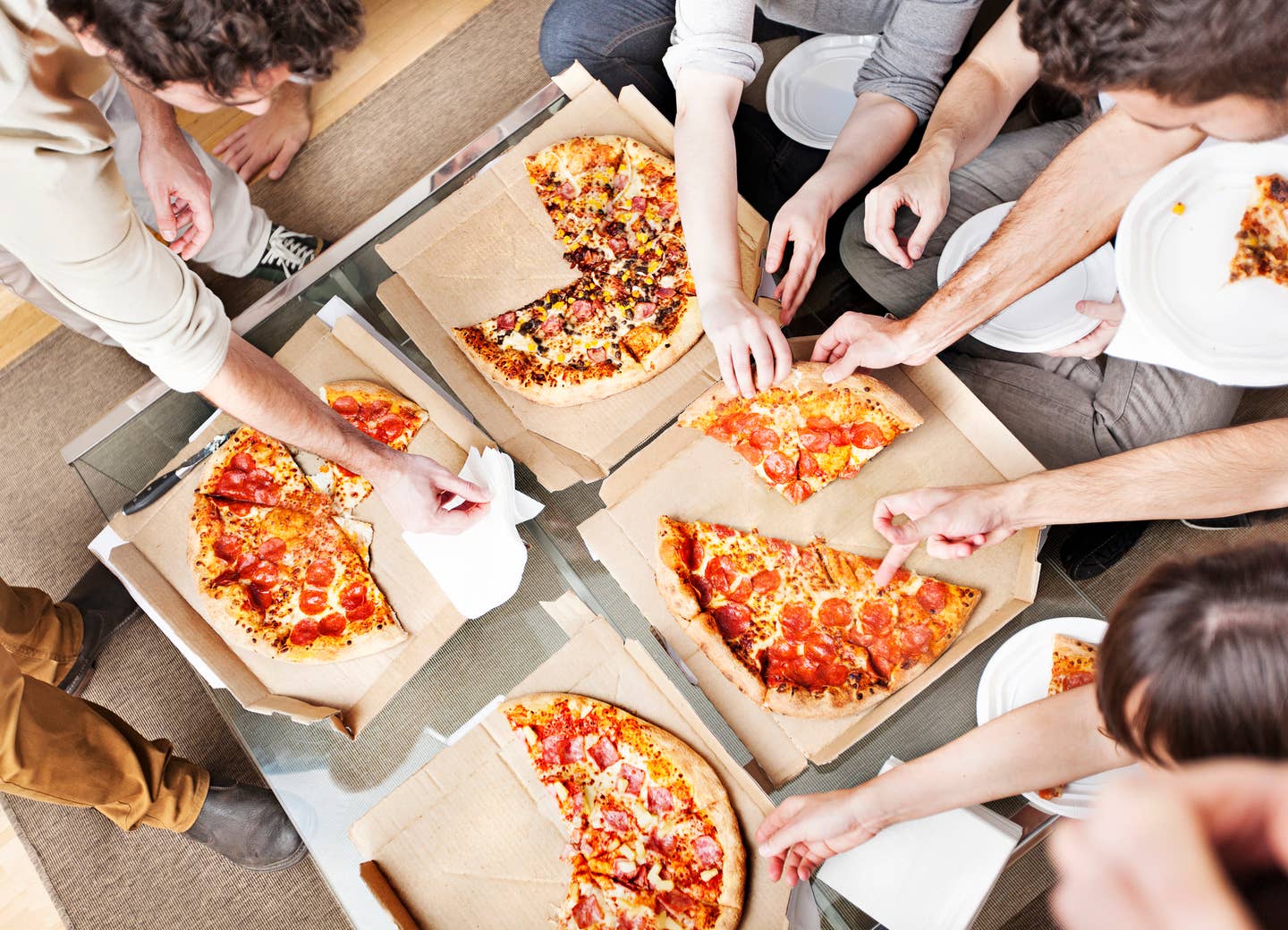
You Eat More Junk Food When You Watch Football. Here’s Why
There's a scientific theory going around that watching fast food ads on TV leads to eating fast food. Really? (I could have told you that without spending time and money on research.) When I watch football and see close-ups of cheesy pizza slices being pulled from the pie, or close up shots of juicy, stacked burgers, crunchy chips, and ice-cold beer, it makes me want to eat pizza, burgers, chips, and beer (and I try to stay away from all that stuff).
This is not unlike in my parents' day, when watching TV and movie stars alluringly smoking cigarettes made them want to smoke. It looked sexy. Cigarette ads were banned as killers in 1970. So what about ads for killer foods? Why are they still on air, enticing us to further stuff ourselves?
The ads during your favorite NFL game (or any other sporting event) are full of close-ups of all sorts of junk food loaded with heart-bursting saturated fat. Researchers have linked these marketing campaigns with having a role in contributing to America's persistent obesity crisis.
Why We Crave Food While Watching TV
The American public is part of a grand Pavlovian experiment. Just as Pavlov's dogs learned to expect food after hearing a bell, we anticipate the sight, smell, and taste of cheesy pizza to arrive at our door shortly after the food ad for that same pepperoni double-stuffed cheesy pie. Okay so we had a role in texting or calling the pizza parlor, but it wasn't our fault. Our cravings were talking.
According to Yale researchers, there is a direct relationship between ads and eating habits. Hedy Kober, a Yale Associate Professor who runs the Clinical & Affective Neuroscience Laboratory there, looked at the effect of exposure to food cues (both virtual and real) on cravings, eating behavior, and weight gain. In reviewing 45 studies that took data from 3,300 participants, Kober and her researcher told NPR they saw a direct connection between food cues and eating behavior.
"We found very, very strong relationships between reactivity and cues and weight and eating," Kober told NPR. The findings, which were published in the journal Obesity Reviews, one would have thought might lead regulators to consider banning advertising food that is harmful to an American public that is overweight and largely on the brink of becoming ill from the foods we eat. Yet that was over six years ago. Nothing happened.
Processed Foods and Diabetes
Currently, over 80 million Americans, one in three adults, have pre-diabetes and don't know it. Pre-diabetes can lead to type 2 diabetes if unchecked. An additional 36 million Americans have full-blown type 2 diabetes, which can be mitigated (at least partly) by eating healthy, whole high-fiber foods like vegetables, fruit, whole grains, legumes, nuts, and seeds and avoiding eating extra calories in the form of animal fat like cheese, as well as simple carbs (in chips) and nutrient-deficient processed foods (like plain pasta or white bread), as well as fast foods and what you could simply call junk food.
Of all the calories we eat, and Americans on average eat over 3,600 calories a day (a 24 percent increase since 1961) nearly 60 percent of them are in the form of highly processed or junk food. If we cut out those unhealthy calories, health advocates and nutritionists believe, we could lower our risk of lifestyle diseases such as type 2 diabetes, heart disease, obesity, high blood pressure, and certain weight-related cancers. (The CDC has identified no fewer than 13 types of cancer that are tied to obesity, so if cancer keeps you up at night, you need to know the connection between diet, weight, and cancer risk.)
So why are these ads still on TV, and driving us to eat everything we shouldn't eat?
Here's another question: Would an ad for a salad drive us to go eat more greens and vegetables? Like not. Humans are hardwired to seek foods that offer us easy calories since our ancestors had to work to find or hunt our next meal. Easy calories ensured survival through famine and long frosty winters. Until, as of the last few generations, food became so abundant that it posed the risk, not the promise of survival.
The Standard American Diet
Because our food systems have engineered the majority of our packaged foods to contain fewer nutrients, yet more calories, more simple carbs, and more saturated fat that can clog our arteries and lead to heart disease, it means that the same regulators who allow food makers to create chips that are hard to stop eating are also allowing these junk food makers to come into our living rooms day after day and night after night to pump up desire and remind us to want these crappy foods. Like cigarettes, they may be killers but they are hard to quit.
Somehow the ads for running shoes and athletic clothes do not make you feel like jumping up from the couch and going running around the block. Why? Because those ads make aspirational lifestyle look like someone else can do it, but not necessarily us. Prize-winning athletes with sleek strong bodies don't resemble our own selves, so there's a gap between what they're doing and what we could achieve.
But the food ads are full of people who look just like us. Ordinary folks enjoying time at home with the family. And the food ads are shot up close, like food porn, pulling apart a slice of pizza that steams and melts in a way designed to make our mouths water.
Food Ads Make Us Crave the Wrong Foods
Just as ads for cigarettes once brainwashed Americans to believe that Viceroys were sexy and Marlboros made you feel as rugged as cowboys, now fast food ads tell you that the social fun of watching your team with friends also must involve consuming large amounts of calories and unhealthy saturated fat.
In 1969 Congress passed legislation banning tobacco ads from television and radio and President Nixon signed the bill into law, effective September 1970. Just about the same time, people began to quit smoking since as a nation we read the warning labels that stated that rather than a sexy habit, smoking causes lung cancer, serious health problems, and early death.
Though for another several decades, tobacco continued to sell its products on billboards and in magazine ads. Now, today we are seeing cheerful pizza delivery guys opening doors to family gatherings and bonding experiences surrounding cheesy foods, carb-centric chips, stacked burgers with bacon, cheese, and fries, and innocent-looking frothy pints of beer.
Don't get me wrong, I love junk food. I used to devour pizza as much as the next guy or gal. (The only thing that holds me back now is the knowledge I've gained about the health impact of eating cholesterol-heavy dairy and meat.) Now that I am avoiding these types of foods, I notice that when you watch TV, especially football, they are everywhere. Let's assume I am a grown-up who can make decisions about when to eat garbage and choose healthier foods. Those ads might tempt me but I have enough discipline (more of the time) and incentive (to be healthy) to pass up the offerings, no matter how fast they promise to get the pizza to my door.
Childhood Obesity and Food Ads
In the younger generations, things are not so cut and dried. While the childhood obesity rate in America has nearly tripled in the last 25 years, with 1 in 5 of our kids now being overweight, we are letting the food companies market to these unhealthy kids without restriction.
Cigarettes and vapes can't make products that are marketed specifically to children, but food companies can. And we are not talking about healthy foods, which rarely if ever advertise. We are talking about the same junk food and fast food that helped create the problem in the first place. If for every pizza ad the company had to buy an ad that promoted health and fitness, there might be some balance.
But since obesity in childhood increases the lifetime risk of diabetes and heart disease, as well as cancer, these ads are literally weaponizing the television that our kids watch, and making it harder for them to make healthy decisions.
The American Psychological Association tells us that research has found strong associations between increases in advertising for non-nutritious foods and rates of childhood obesity. Most children under age 6 cannot distinguish between programming and advertising and children under age 8 do not understand the persuasive intent of advertising. Advertising directed at children this young is by its very nature exploitative."
Meanwhile, childhood obesity is climbing, and many of these ads are directed at kids who don't always know the difference between programming and marketing. One study found that within 30 minutes of watching healthy ads, kids will make unhealthy food choices, according to research out of Canada that was published in the journal Obesity Reviews.
Someday we may look back at this time in our history as the moment when the food companies were allowed to lead Americans over a cliff into the nutrition-devoid abyss. Until the day when food ads are regulated, and not allowed into our national pastimes like football, baseball, hockey, basketball, or any televised ball games, it's up to us to resist their temptations and make healthier game-day eats. Here is a list of our suggestions. There's always vegetarian chili and guacamole (try it with cruditée for a healthier alternative to chips).
Bottom Line: Watch the Game and Plan Ahead With Healthier Game Day Eats
More From The Beet






